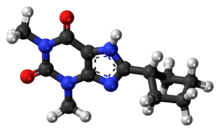8-Cyclopentyl-1,3-dimethylxanthine
 | |
 | |
| Clinical data | |
|---|---|
| ATC code | none |
| Legal status | |
| Legal status |
|
| Identifiers | |
| |
| CAS Number |
35873-49-5 |
| PubChem (CID) | 1917 |
| IUPHAR/BPS | 385 |
| ChemSpider |
1843 |
| ChEMBL |
CHEMBL106265 |
| Chemical and physical data | |
| Formula | C12H16N4O2 |
| Molar mass | 248.280 g/mol |
| 3D model (Jmol) | Interactive image |
| |
| |
| (verify) | |
8-Cyclopentyl-1,3-dimethylxanthine (8-Cyclopentyltheophylline, 8-CPT, CPX) is a drug which acts as a potent and selective antagonist for the adenosine receptors, with some selectivity for the A1 receptor subtype, as well as a non-selective phosphodiesterase inhibitor. It has stimulant effects in animals with slightly higher potency than caffeine.[1][2]
See also
References
- ↑ Spealman RD (1988). "Psychomotor stimulant effects of methylxanthines in squirrel monkeys: relation to adenosine antagonism". Psychopharmacology. 95 (1): 19–24. doi:10.1007/bf00212759. PMID 3133696.
- ↑ Karcz-Kubicha M; Antoniou K; Terasmaa A; Quarta D; Solinas M; Justinova Z; Pezzola A; Reggio R; Müller CE; Fuxe K; Goldberg SR; Popoli P; Ferré S (July 2003). "Involvement of adenosine A1 and A2A receptors in the motor effects of caffeine after its acute and chronic administration". Neuropsychopharmacology. 28 (7): 1281–91. doi:10.1038/sj.npp.1300167. PMID 12700682.
| Receptor (ligands) |
| ||||||||||||||||
|---|---|---|---|---|---|---|---|---|---|---|---|---|---|---|---|---|---|
| Transporter (blockers) |
| ||||||||||||||||
| Enzyme (inhibitors) |
| ||||||||||||||||
| Others | |||||||||||||||||
This article is issued from Wikipedia - version of the 5/17/2016. The text is available under the Creative Commons Attribution/Share Alike but additional terms may apply for the media files.